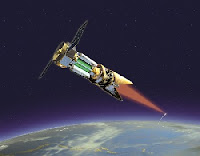For better or worse, cell phones are a part of our lives. I say this
because they can be convenient when needed, but there's nothing more
annoying than a dropped call or an inconveniently timed ring tone. Since
many people carry their phones with them daily, there has been a number
of studies which ask what are the long-term health effects of cell phone
usage. While the controversy
rages
among medical researchers, I decided to find my own answers by doing a
calculation based on the power output of a simple hand set. The key
physical idea in this calculation is Faraday's law. You can check
Wikipedia for a lengthy
article
describing it, but I'm more interested in getting down to business. Now,
from the antenna of every cell phone, an electromagnetic wave is
emitted. This EM wave, has magnetic and electric components which
oscillate back and forth across space and through time. To quantify the
effects of this EM wave on a human being, I'm going to focus on just the
brain. In the simplest case, I would imagine it as a homogeneous blob.
Unfortunately, this model is too simplistic and looses the all the
interesting physiology. Instead, I'm going to treat the brain as a
collection of loops made by neurons. In this model, I imagine that every
neuron is connected to many other neurons by electrically conducting
dendrites and axons. Some neurons will be connected to each other in two
places, thus creating a small continuous loop. This loop has some area
$$ A $$ and as the EM wave from the cell phone passes by, it induces an
EMF a la Faraday's law: $$ \epsilon = \frac{ d\phi}{dt}. $$ Well,
since the flux $$ \phi = \textbf{B} \cdot \textbf{A} \approx \pi
r^2 E / c,$$ and the electric field is an oscillatory function $$ E =
E_0 \cos \omega t,$$ we have $$ \epsilon = \frac{\pi r^2 \omega
E_0}{c} \cos \omega t, $$ where $$r$$ is the radius of the neuron
loop, $$\omega = 2 \pi f$$ is the frequency of cell phone carrier
waves and $$c $$ is the speed of light. Taking the root mean square gets
rid of the cosine factor and gives $$ \epsilon_{rms} = \frac{ \pi
r^2 \omega}{c} E_{rms}. $$ So, if I know the RMS amplitude of the EM
waves coming from my cell phone, then I will be able to calculate the
induced voltage in a given neuron loop. Fortunately, there's a
convenient set of formulae which relates power output to the RMS
amplitude: $$ \frac{ \langle P \rangle}{A} = I = \langle u_E
\rangle c = \epsilon_0 c E^2_{RMS} \quad \rightarrow \quad
E_{RMS} = \left( \frac{ \langle P \rangle}{\epsilon_0 c A}
\right)^{1/2}. $$ This line of gibberish is relating the intensity $$
I $$ to the power per unit area as well as the average energy density,
which in turn is expressed in terms of $$E_{RMS}. $$ The final
expression can now be substituted to find $$ \epsilon_{rms} = \frac{2
l^2 f}{c} \left( \frac{ \langle P \rangle}{\epsilon_0 c 4 \pi
R^2} \right)^{1/2}. $$ Here, I've made a few additional substitutions
to get the formula in terms of real numbers. In particular, I've
converted from $$r, $$ the radius of a neuron loop to $$l, $$ the length
of an individual neuron when two of them form a loop. Also, I'm using
$$R$$ to denote the distance from the cell phone antenna to the neuron
loop in your head. I think a reasonable number for this should be about
10 cm, yeah? Okay, now here comes the fun part. I asked around to look
at peoples cell phones, and I found that roughly, they all run at 1 W of
power. Furthermore, according to an introductory physics text, cell
phones operate at around $$ 10^9 Hz $$ and from a little web browsing,
$$ l = 10^{-3} \sim 10^1 $$ meters. Since the length of neurons seems
to vary quite a bit, I've written the expression as $$ \epsilon = l^2
\times (360 V/m^2). $$ So for two neurons about a mm long in the same
vicinity, there's a pretty decent chance they'll make contact with each
other at two points. Thus, the induced voltage is about 0.36 mV. On the
off chance two longer neurons form a loop (taking $$l \sim 10^{-2} $$
meters), the induced voltage is about 36 mV. Finally if two REALLY long
neurons ($$ l \sim 1$$ meter) make a loop (mind you, the chances of
this are zero since the circular area they would form is bigger than
your body!), then the induced voltage is 360 V. Electrifying! To compare
these numbers to something useful, consider that the brain is constantly
sending electrical signals at around 100 mV (this is called the Action
Potential). Since the most probbable induced voltage (0.36 mV) in
significantly smaller than the action potential (less than 1%), we can
conclude that the cell phonne EM waves are essentially negligable
effects. Like I said earlier, this is an extremely simple model for the
brain, but it does illustrate a particular mechanism by which common
technology can interfere with our biology. And yes, I trust that the
calculation is correct, but while the experiments are showing higher
incidence of tumors coinciding with cell phone use, well, I'm just limit
my talk time.



